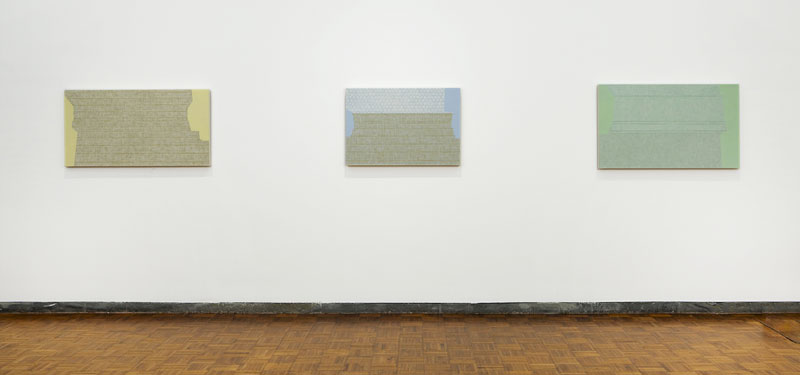Francesco Bonami and Gary Carrion-Murayari, Curators
Julia Fish
Although the layered, geometric forms of Julia Fish’s paintings bear some resemblance to the mystifying plastic forms found in a De Stijl painting, Fish’s work is representative, mostly specific to, or subjectively derived from, a given source in the artist’s immediate surroundings. The subtle tension between the clearly defined shapes and the pale receding grounds of Fish’s minimal and coloristically rigid, compositions is analogous to the balance between ideas of abstraction and representation inherent in her work.
Fish has spent more than twenty years contemplating aspects of the private space of her home, garden and studio. Operating under a reductive schema, her work examines interstitial moments that address patterns of her human experience. Fish’s work is reminiscent of Gordon Matta-Clark’s archiving and photographing of the space—cracks, corners, and crevices—between the buildings and sidewalks of New York in his unrealized project of the early 1970s Fake Estates. Like Matta-Clark yet on a more personal scale, Fish invites disorientation across her suites of architectural elevations, plans and sections as in her in-process set of six “threshold” paintings. In addition to representing the transitional space between rooms in her home through layers of near-gray, Fish incorporates one of the three primary or the three secondary colors into each painting—this investigation informed by the image of light translated as spectrum is evident in her 2009 canvas Lumine II, Northwest [ Parhelion ]. Delineated white-gray areas result in a sort of topography—a map of a fragment of the threshold—which emerges from a foundation of color.
Obeying a symbolic language Fish has engineered, all of these works embody a mathematical precision: the measurements link to the specific dimensions of the rooms and spaces that they represent and from which they emerge. Yet despite the rigor of her pictorial vocabulary, ordinary subjects turn enigmatic. Fish writes, “I want the painted object to stretch the meaning of a given subject, to rearrange its visual syntax into another form of knowing, and to engage the larger history of images that have preceded it.” Fish invites us to infiltrate the space between and to question its contours, and ultimately to fill its void with our own archetypes and allusions.
– TK / Tina Kukielski, 2010 – Whitney Biennial, exhibition catalogue

